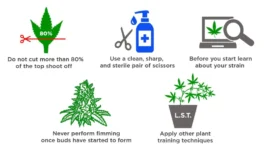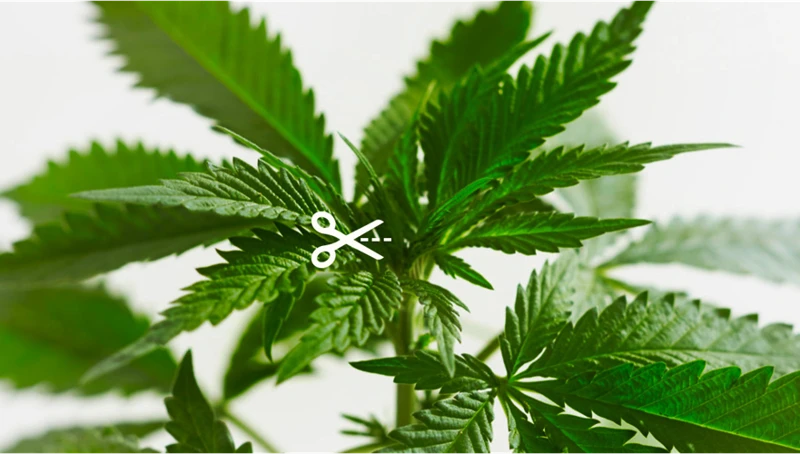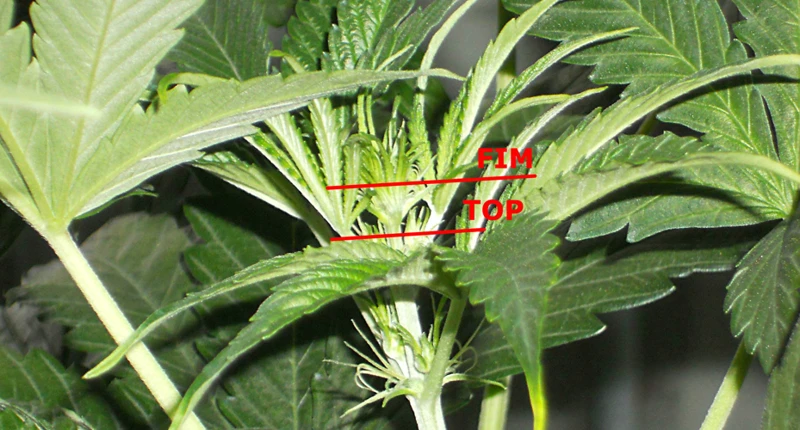
Can Fimming be Used on Autoflowering Cannabis Strains?
As autoflowering cannabis continues to gain popularity in the world of cannabis cultivation, many growers are wondering whether or not Fimming – a popular pruning technique – can be applied to these types of strains. There are conflicting opinions and advice out there, and the subject can be quite perplexing to those just starting out with autoflowering plants. In this article, we’ll delve deep into the topic of Fimming and explore the truth about whether it can be safely and effectively done on autoflowering cannabis. We’ll also provide step-by-step instructions and tips for those who want to give it a try. So sit tight, and let’s explore the world of Fimming and autoflowering cannabis together.
What is Fimming?
Contents
If you are new to cannabis cultivation, you may have come across the term “Fimming” and wondered what it means. Fimming is a technique used by growers to increase the yield of their cannabis plants. This method involves removing a portion of the plant’s vegetative growth to encourage bushier growth and promote more colas (bud sites) to develop. Fimming is often compared to the more well-known technique of topping, but there are some important differences between the two. Let’s take a closer look at Fimming and how it can benefit your cannabis breeding efforts.
The Benefits of Fimming on Cannabis Breeding
One of the most significant benefits of fimming on cannabis breeding is the ability to produce more colas, or flowering tops. This can lead to higher yields and a more robust plant structure. When a plant is fimmed, it causes the lateral branches to grow more vigorously, producing larger-sized colas in addition to the main cola. This process also results in a more even canopy distribution, which can help increase light penetration and improve the plant’s overall growth and development.
Another benefit of fimming is that it can encourage bushier growth, producing a more extensive canopy of leaves. Since the plant’s energy is redirected to the lateral branches, it can result in a more balanced growth and a more even distribution of energy and nutrients throughout the plant. This can also improve the plant’s ability to resist pests and diseases, ultimately resulting in a healthier, more abundant harvest.
Fimming can help to shorten the vegetative stage of the plant, allowing for a quicker transition to the flowering stage. This can be especially beneficial for breeders who are looking to produce multiple harvests in a shorter timeframe.
Fimming is an effective method for increasing yields, improving plant structure and health, and shortening the vegetative stage of cannabis plants. By understanding how to fim properly and utilizing careful timing, breeders can harness these benefits to produce the best possible results from their cannabis plants.
| Benefits of Fimming on Cannabis Breeding |
|---|
| Increased production of colas |
| Encourages bushier growth |
| Shortens vegetative stage |
Can You Fim Autoflowering Cannabis?
Autoflowering cannabis strains have become incredibly popular due to their fast growth, limited size, and ease of cultivation. However, many growers wonder if it’s possible to FIM these types of plants. On one hand, Fimming is a technique that can result in higher yields and bushier plants. On the other hand, autoflowering cannabis has a unique growth pattern that may not respond well to this method. So, the question arises, can you FIM autoflowering cannabis? Let’s explore the answer in detail.
Autoflowering Cannabis: An Overview
Autoflowering cannabis is a relatively new type of cannabis that has emerged in recent years. This type of cannabis is known to have a shorter growth cycle and is ideal for growers who are looking for a quick and easy way to grow cannabis. Here are some key points to keep in mind when it comes to autoflowering cannabis:
- Genetics: Autoflowering cannabis is created by crossing cannabis plants with the ruderalis plant. Ruderalis plants are known for their ability to flower based on age and not on light cycles, which is what makes them ideal for creating autoflowering cannabis strains.
- Growth Cycle: Autoflowering cannabis has a much shorter growth cycle compared to traditional cannabis plants. They typically grow from seed to harvest within 8-12 weeks, which is significantly faster than other strains that can take up to 6 months or more.
- Size: Autoflowering cannabis plants are typically smaller in size compared to traditional cannabis plants. They usually grow to a height of around 1-3 feet tall, which means they are ideal for growers who have limited space.
- THC Content: Autoflowering cannabis plants are known to have a lower THC content compared to other types of cannabis strains. However, they still contain enough THC to produce a potent high.
- Yield: The yield from autoflowering cannabis plants is usually smaller compared to traditional cannabis strains. However, this can depend on the specific strain and growing conditions.
- Difficulty: Autoflowering cannabis is generally considered easier to grow compared to traditional cannabis strains because they require less attention and are less sensitive to light cycles. However, fimming autoflowering cannabis can be more challenging and may not always produce the desired results.
Autoflowering cannabis is a popular choice among growers who are looking for a fast and easy way to grow cannabis. While it may have some limitations, it can still produce high-quality buds that are sure to please any cannabis enthusiast.
Challenges of Fimming Autoflowering Cannabis
When it comes to fimming autoflowering cannabis, there are a few unique challenges that growers need to consider. Here are some challenges you may encounter:
- Timing: Autoflowering strains have a fixed growth cycle, which means that timing is critical when fimming them. If you fim too early, you risk stunting the plant’s growth, while fimming too late can affect the plant’s overall yield.
- Recovery: Unlike photoperiod strains, autoflowers don’t have as much time to recover from any damage caused during the fimming process. As a result, it’s crucial to be gentle when fimming and provide the plant with the necessary care and nutrients to aid in the recovery process.
- Yield: Autoflowers typically produce smaller yields than photoperiod strains. Although fimming can increase yields in photoperiod strains, there’s a risk that autoflowers might not respond well to the technique, leading to even smaller yields.
- Plant Stress: Fimming is a form of plant stress, and when done improperly or on a sensitive plant, it can lead to other problems, like causing the plant to turn hermaphrodite or interrupting its natural growth cycle.
It’s crucial to remember that while fimming has benefits, it’s not necessary for growing healthy cannabis plants, and it might not be suitable for all strains. Before attempting to fim an autoflowering strain, research the specific strain’s characteristics and growth patterns to determine whether it’s worth the risk.
How to FIM Autoflowering Cannabis?
So, you’ve decided to try out Fimming on your autoflowering cannabis plants, but you’re not quite sure how to do it. Don’t worry, Fimming can seem daunting at first but with a bit of guidance, you’ll soon be on your way to an abundant harvest. Fimming can offer some significant benefits to your grow, including increased yields and improved overall plant health. In this section, we will guide you through the process of Fimming your autoflowering cannabis plants step-by-step, so you can enjoy all the benefits that come with it. Let’s get started!
Step-by-step Guide on Fimming Autoflowering Cannabis
Fimming autoflowering cannabis can be a bit tricky, but with the right technique and approach, it can enhance the overall yield and potency of your cannabis plant. Here is a step-by-step guide on how to FIM your autoflowering cannabis:
Step 1: Wait Until The Plant Is At Least 3-4 Weeks Old
Timing is key when it comes to FIMing autoflowering cannabis. You should wait until the plant is at least 3-4 weeks old when it has developed a substantial amount of foliage, but not too big that it becomes difficult to manipulate.
Step 2: Identify The Growth Tips To FIM
The next step is to identify the growth tips that you want to FIM. Look for the newest and most vibrant leaves located at the top of the plant, just beneath the main shoot. These growth tips are responsible for the vertical growth of the plant, so by FIMing them, you are redirecting the plant’s energy to create more branches and lower growth.
Step 3: Use Sharp And Sterile Scissors
It is essential to use sharp and sterile scissors when FIMing your autoflowering cannabis. This is to prevent any damage or infection to the plant. You can sterilize the scissors by wiping them down with rubbing alcohol or dipping them in boiling water.
Step 4: Cut The Growth Tips
Using the scissors, cut the top of the growth tips, leaving about 80% of the tip intact. The goal is to create a clean, diagonal cut just above the second or third set of leaves from the top. Be careful not to cut too close to the stem, as this could damage the plant.
Step 5: Observe The Results
After a few days, you will notice new growth emerging from the cut stems. This is a sign that the FIM has been successful, and the plant is redirecting its growth energy to create more branches and buds. From here, you can observe the plant’s growth and make any necessary adjustments to support its development.
Step 6: Repeat The Process
You can repeat the FIMing process as necessary to achieve the desired shape and size of your autoflower cannabis plant. However, it is crucial to give the plant enough time to recover between cuttings, usually around two weeks.
Remember, FIMing is not an exact science and may not produce the same results for every plant. However, with patience and practice, you can use this technique to enhance the overall yield and potency of your autoflowering cannabis plant.
Fimming Tips and Tricks for Autoflower Cannabis
To ensure successful Fimming of Autoflower Cannabis, there are certain tips and tricks that you need to keep in mind. Here are some tips and tricks to guide you through the process:
| Tip/Trick | Description |
|---|---|
| Timing is Key | It is important to fim at the appropriate time to prevent stunting the growth of your plant. Make sure your plant has sufficient nodes (5-6 nodes) before fiming. |
| Use Clean Tools | Ensure that your tools, such as scissors or a sharp razor blade, are clean and sterilized. This will prevent the transfer of diseases or pests to the plant during the fiming process. |
| Be Precise | Make sure you make a precise cut in the right spot. The cut should be directly above the third or fourth node, leaving only about 20-25% of the tip. |
| Don’t Overdo It | It is easy to get carried away and fim too many leaves at once. Avoid fiming more than 2-3 leaves at a time to prevent stunting the growth of the plant. |
| Support the Plant | After fiming, the plant may become top heavy and require support to prevent breakage. Use materials such as stakes, string or trellis netting to support the plant. |
| Stay Vigilant | Watch for any signs of stress or disease post-fiming. Pay attention to the plant’s response, and adjust your care as necessary. |
| Practice Makes Perfect | Fimming Autoflower Cannabis can be challenging, especially for beginners. Don’t be discouraged by initial failures, keep practicing and refining your technique. |
By following these tips and tricks, you can increase your chances of success when Fimming Autoflower Cannabis. Remember to be patient, stay attentive, and keep practicing to become an expert in Fimming Autoflower Cannabis.
Conclusion
In conclusion, Fimming can be a viable option for cannabis growers looking to increase their yield and achieve bushier plants. However, it is essential to keep in mind that Fimming is not suitable for all cannabis plants, especially autoflowering strains.
Before attempting Fimming on your plants, it is crucial to research and understand the specific strain’s growth patterns and potential response to Fimming. In general, it is better to avoid Fimming autoflowering strains and focus on Low Stress Training techniques that do not rely on topping or cutting the plants.
For those who decide to experiment with Fimming, it is essential to follow the proper steps carefully and avoid damaging the plant. Fimming requires precision and gentleness, and any mistakes can set back or even ruin the plant’s growth.
Additionally, Fimming should be complemented with a balanced nutrient regimen, adequate lighting, and an optimal environment to ensure the plant’s health and yield.
In summary, Fimming can be an effective technique for increasing yields and shaping cannabis plants, but it should not be blindly applied to all strains, especially autoflowering ones. Proper research, preparation, and execution are essential to achieving positive results with Fimming.
Frequently Asked Questions
Can Fimming Autoflowering Cannabis Increase Yield?
Yes, Fimming can increase the yield of Autoflowering Cannabis by creating multiple colas and increasing overall plant density.
What is the Best Time to Fim Autoflowering Cannabis?
The best time to Fim Autoflowering Cannabis is during the vegetative stage when the plant has at least 4-5 nodes.
Can Fimming Cause Stress to Autoflowering Cannabis?
Yes, Fimming Autoflowering Cannabis can cause stress, especially if not done correctly. However, proper technique and care can minimize stress and promote healthy growth.
How Do You Know If Fimming Was Successful on Autoflowering Cannabis?
You can tell if Fimming was successful on Autoflowering Cannabis by noticing new leaf growth at the site of the Fimming cut, and multiple colas starting to form.
Does Fimming Autoflowering Cannabis Affect THC Levels?
No, Fimming Autoflowering Cannabis does not affect THC levels. THC levels are determined by the genetics of the plant and growing conditions.
What Tools Do You Need to Fim Autoflowering Cannabis?
You need sharp, sterile scissors or pruning shears to Fim Autoflowering Cannabis.
Is Fimming Autoflowering Cannabis Suitable for Indoor Growing?
Yes, Fimming Autoflowering Cannabis is suitable for indoor growing as it can help control the plant’s height and increase yield within limited space.
Can You Fim Autoflowering Cannabis Multiple Times?
Yes, you can Fim Autoflowering Cannabis multiple times, but it is important to wait for new growth between each Fimming to avoid causing too much stress to the plant.
How Long Does It Take for Autoflowering Cannabis to Recover from Fimming?
Autoflowering Cannabis typically recovers from Fimming within 3-7 days, but this can vary depending on the plant’s genetics and growing conditions.
Is Fimming Autoflowering Cannabis Suitable for Beginners?
While Fimming Autoflowering Cannabis can be beneficial, it requires careful technique and attention to detail. Beginners may want to practice on non-autoflowering plants before attempting Fimming on Autoflowering Cannabis.




